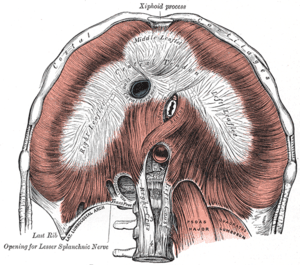Median arcuate ligament
| Median arcuate ligament | |
|---|---|
 The diaphragm. Under surface. | |
| Details | |
| Identifiers | |
| Latin | ligamentum arcuatum medianum |
| TA | A04.4.02.005 |
| FMA | 58281 |
The median arcuate ligament is a ligament under the diaphragm that connects the right and left crura of diaphragm.
Structure
The median arcuate ligament is formed by the right and left crura of the diaphragm. The crura connect to form an arch, behind which is the aortic hiatus, through which pass the aorta, the azygos vein, and the thoracic duct.
Clinical significance
Compression of celiac artery and celiac ganglia by the median arcuate ligament can lead to the median arcuate ligament syndrome, which is characterized by abdominal pain, weight loss, and an epigastric bruit.[1]
See also
References
This article incorporates text in the public domain from the 20th edition of Gray's Anatomy (1918)
- ↑ Duncan AA (April 2008). "Median arcuate ligament syndrome". Curr Treat Options Cardiovasc Med. 10 (2): 112–6. doi:10.1007/s11936-008-0012-2. PMID 18325313. Archived from the original on December 4, 2012.
External links
- Anatomy figure: 40:04-08 at Human Anatomy Online, SUNY Downstate Medical Center - "The abdominal surface of the diaphragm."
- 1738145849 at GPnotebook
- posteriorabdomen at The Anatomy Lesson by Wesley Norman (Georgetown University) (posteriorabdmus&nerves)
This article is issued from Wikipedia - version of the 9/8/2016. The text is available under the Creative Commons Attribution/Share Alike but additional terms may apply for the media files.